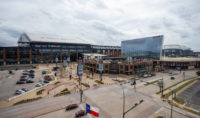The Chandler, Ariz., office of construction manager at-risk Mortenson Construction began the $72-million, two-phase project in January and delivered the first phase in time for the first home football game of the season at the beginning of this month. The second phase is scheduled for completion by July 2013.
Phase 1 construction began with demolition of the north end-zone structure and bleachers, the installation of underground utilities and setting the lower bowl precast seating up to level three. New lighting was placed, and the field was restored with natural turf.
BIM was used to fast-track the first phase and all other aspects: foundations, finishes, utilities and MEP rough-ins. The project team also leveraged the university's cave automatic virtual environment (CAVE) to preview designs.
"While in the CAVE, it also gave the team a chance to make decisions that would otherwise be impossible until the facility was constructed," says Chris Norcross, vice president and general manager for Mortenson Construction. "Use of this technology has allowed for more accurate and timely team collaboration."
The new concrete superstructure will connect the east and west sides of the stadium and wrap around the north side so the concourses connect. Underneath the new seating will be a new home for the football team operations, including weight rooms and offices. For the superstructure, crews drove 100-plus concrete caissons 25 to 50 ft deep.
Good Neighbors
Because there are significant structural elements that incorporate architectural concrete as the finish condition, the logistics and coordination necessary have led some to call this a "Swiss watch" of a project, says Eric Grenz, an executive at Mortenson. The firm is self-performing the concrete work. At the same time, Mortenson has stayed local, with 70% of the work awarded to Tucson area businesses and 85% of the work force from Tucson, he says.
The stadium is close to multiple residence halls and academic buildings. In addition, the stadium also houses the Steward Observatory Mirror Polishing Lab and a Tree Ring Lab at the east end, both requiring quiet environments. Because of this, communication with the university has been essential. "Student and public safety, along with disruption avoidance, is paramount," Norcross says. "Disruption to campus operations is not an option for the project team."
To alleviate potential scheduling conflicts with the 2012 football season and school semester, Mortenson assigned two employees as disruption-avoidance coordinators with the many university stakeholders. Construction will be halted during Saturday home football games but will continue throughout the season on the exterior enclosure, interior rough-in and finishes and site improvements.
"The site logistics surrounding the project have been set up in such a manner to still allow students, fans and spectators to migrate to their seats with as little impact as possible," Grenz says.













Post a comment to this article
Report Abusive Comment